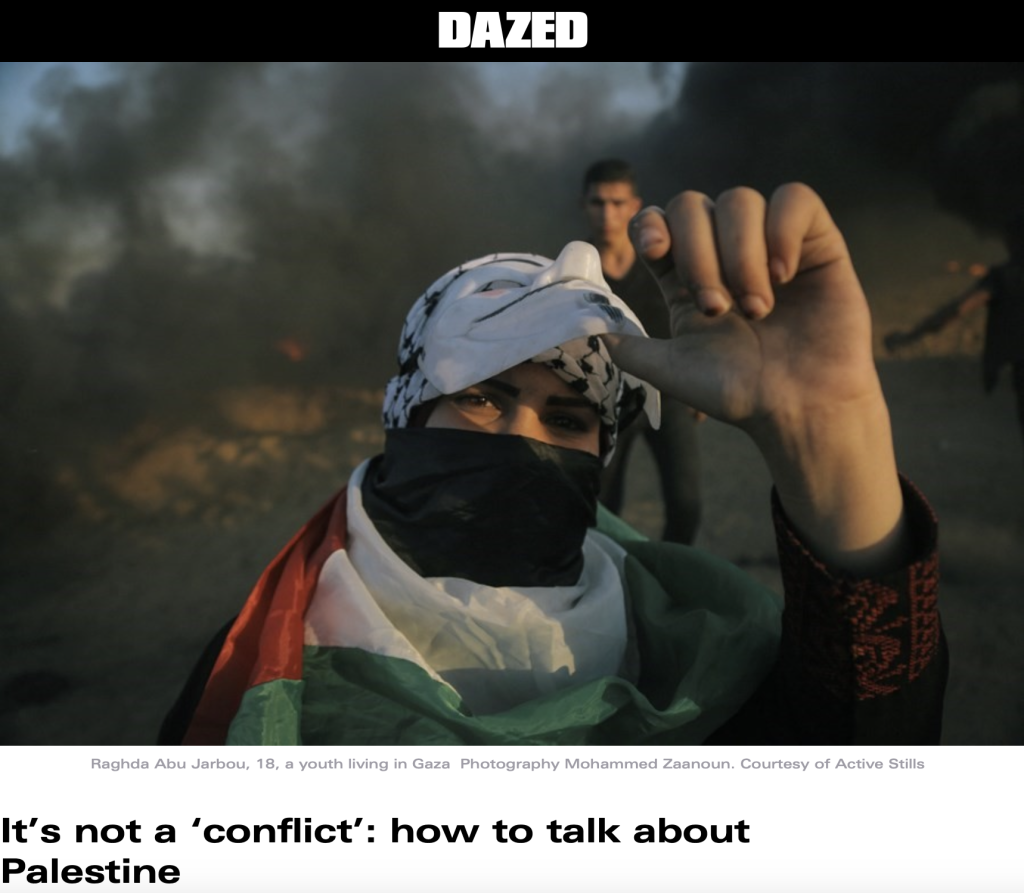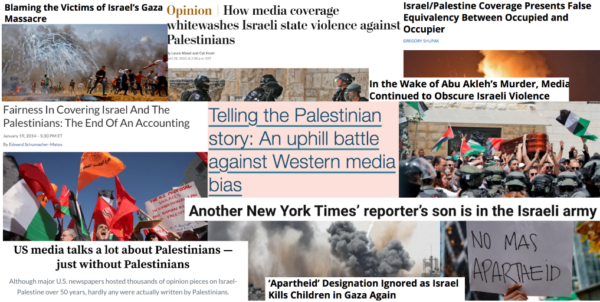(Featured image is taken from Jewish Voice for Labour).
The current situation in Palestine is a complex and deeply rooted conflict that has garnered global attention. However, how this issue is framed and presented by the media plays a crucial role in shaping public opinion. Drawing on the framework of “manufacturing consent,” as discussed by Durham and Kellner, this blog post explores how media coverage and the dissemination of information influence public perception of the Palestinian-Israeli conflict. By looking at the construction of different narratives and potential biases, we can gain a deeper understanding of how media influences public opinion.
Durham and Kellner emphasize that media plays a central role in constructing narratives. Media outlets select, frame, and prioritize certain stories, thereby influencing public perception. In the case of the Israeli-Palestinian conflict, the dominant narrative often centers around the Israeli perspective, focusing on security concerns and the threat posed by Palestinian resistance groups. Mainstream media tends to frame the conflict in a way that prioritizes certain perspectives while marginalizing others. For example, the narrative of Israeli security concerns is often portrayed prominently, while the voices and experiences of Palestinians are often sidelined or ignored. This narrative can marginalize or overshadow the Palestinian perspective, perpetuating an unequal power dynamic in media coverage.
Manufacturing consent in the context of the Israel-Palestine conflict can also be traced back to biases that exist within media institutions and the wider social and political landscape. The influence of pro-Israel lobbying groups, the amplification of fear-inducing narratives, and the framing of Palestinian resistance as terrorism are examples of how biases can skew public opinion. Biases can manifest in various ways, including linguistic, cultural, and political biases that influence how events are portrayed. Critics argue that many Western media outlets portray Israel in a positive light while demonizing Palestinians, often using language that frames Palestinians as aggressors and Israel as defenders. Such biases contribute to a distorted perception of the conflict, influencing public opinion and reinforcing existing power dynamics.
In addition to biases and narrative construction, the way we talk about the situation in Palestine is crucial. The article “It’s not a ‘conflict’: how to talk about Palestine” by Dazed emphasizes the importance of using accurate and descriptive language to avoid perpetuating false equivalences and minimizing the power dynamics at play. Language choices can contribute to or challenge the manufacturing of consent, as they shape public understanding and perception of the conflict.

The dissemination of information through media channels significantly impacts public perception of the Israeli-Palestinian conflict. The public relies on media reporting to comprehend events taking place in distant regions. However, media coverage that emphasizes one side’s narrative over the other can distort the reality on the ground and hinder the public’s access to a comprehensive understanding. This can result in a lack of empathy towards the suffering experienced by Palestinians or an oversimplified viewpoint of the conflict.
The evolution of technology and the rise of social media platforms have allowed for a more diverse range of voices and perspectives to be heard. However, this also means that misinformation, propaganda, and manipulation can spread rapidly. As Schuman highlights, the dissemination of information in the digital age can perpetuate biases and further entrench existing narratives. The ability to carefully curate online information feeds and the prevalence of echo chambers contribute to the polarization of opinions on the Israeli-Palestinian conflict.

Durham and Kellner’s work encourages critical questioning and challenges to biased media coverage. An increasing number of journalists, activists, and scholars have started to question and challenge biased media coverage of the Israeli-Palestinian conflict. They argue for a more nuanced approach that considers multiple perspectives, highlights human rights abuses experienced by Palestinians, and challenges the dominance of the Israeli narrative. Alternative media outlets and social media platforms have also played a significant role in providing alternative viewpoints and amplifying marginalized voices. Journalists, even within renowned outlets like the BBC, have accused their own organization of bias. These critiques demonstrate the importance of critically examining media sources and avoiding a reliance on a single narrative.Public perception of the situation in Palestine is heavily influenced by media coverage and the dissemination of information.
The manufacturing of consent through the construction of narratives, biases, and potential unprofessionalism affects how people understand and engage with this complex issue. Recognizing and challenging these dynamics is crucial to promoting a more nuanced understanding and fostering an environment for constructive dialogue and potential resolution
References –
Afana, R. (2023). The Occupation–Colonialism Continuum: Impact on Transitional Justice in Palestine/Israel. [online] brill.com. Available at: https://brill.com/edcollchap/book/9789004503939/BP000008.xml.
Al Jazeera. (n.d.). Why is Western media accused of bias on Israel-Palestine? [online] Available at: https://www.aljazeera.com/program/inside-story/2023/11/11/why-is-western-media-accused-of-bias-on-israel-palestine.
Caballero, J.X. (2010). The Impact of Media Bias on Coverage of Catastrophic Events:Case Study from The New York Times’ Coverage of the Palestine/Israel Conflict. [online] d-scholarship.pitt.edu. Available at: https://d-scholarship.pitt.edu/7515/.
Christison, K. (2023). Perceptions of Palestine: Their Influence on U.S. Middle East Policy. [online] Google Books. University of California Press. Available at: https://books.google.co.uk/books?hl=en&lr=&id=5hesBrK0vbcC&oi=fnd&pg=PP11&dq=palestine&ots=rmudzfu2Cr&sig=TRSx58mzOirOirvbsDc_rjFMWAo&redir_esc=y#v=onepage&q=palestine&f=false.
Ghareeb, E., Jennings, P., Koven, R., McCartney, J., Eggerstrom, L. and Robinson, M. (1975). The American Media and the Palestine Problem. Journal of Palestine Studies, 5(1/2), pp.127–149. doi:https://doi.org/10.2307/2535687.
It’s not a ‘conflict’: how to talk about Palestine. (2021). Dazed. [online] 14 May. Available at: https://www.dazeddigital.com/politics/article/52785/1/it-is-not-a-conflict-how-to-talk-about-palestine-israel.
Loewenstein, A. (2023). The Palestine Laboratory: How Israel Exports the Technology of Occupation Around the World. [online] Google Books. Verso Books. Available at: https://books.google.co.uk/books?hl=en&lr=&id=4o2EEAAAQBAJ&oi=fnd&pg=PA1&dq=palestine+occupation&ots=JFa79X9t_g&sig=SFSBC2G8CYTUxqf9Uk8m5qNgGH4&redir_esc=y#v=onepage&q=palestine%20occupation&f=false.
Murphy, R., Ferrara, A. and Power, S. (2023). The Occupation of Palestine from a TWAIL Lens. [online] brill.com. Available at: https://brill.com/edcollchap/book/9789004503939/BP000005.xml.
Nashed, M. (2023). Western coverage of Israel’s war on Gaza – bias or unprofessionalism? [online] www.aljazeera.com. Available at: https://www.aljazeera.com/news/2023/10/29/western-coverage-of-israels-war-on-gaza-bias-or-unprofessionalism.
Schulman, S. (2023). Explanations Are Not Excuses. [online] Intelligencer. Available at: https://nymag.com/intelligencer/2023/10/israel-gaza-war-manufactured-consent.html.
Short, E. BBC accused by its own journalists of bias in its coverage of Israel’s war on Gaza. [online] Morning Star. Available at: https://morningstaronline.co.uk/article/bbc-accused-own-journalists-bias-its-coverage-israels-war-gaza.

